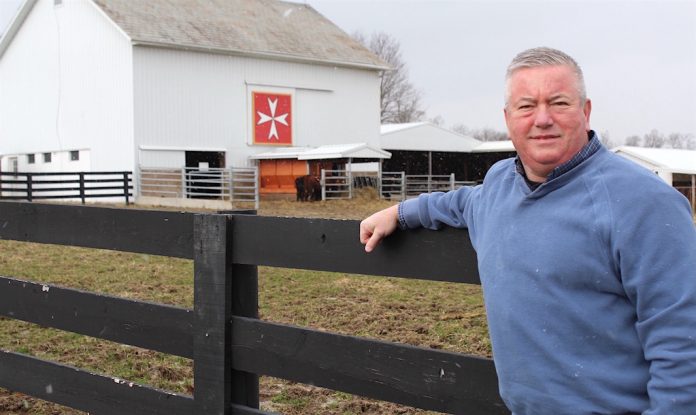ZANESVILLE, Ohio — The 60-plus head of beef cattle that Muskingum County farmer Todd Sands keeps on pasture take a fair amount of time and effort.
Because he focuses on grazing, the grass-fed cattle take longer to finish than if they were in a feedlot, and because he tries to rotate them to a new pasture every day, there’s something that always needs done.
But while the cattle require work, they also keep their owner going, and provide him with hope and optimism.
After surviving a life-threatening experience with cancer about 20 years ago, which started in a kidney and was later discovered in his lungs, his wife made a deal with him. If he fought hard and recovered, he could move the family anywhere he wanted — including his dream of having his own farm.
“She said to me, ‘if you make it through this, you can live wherever you want to live.’ And I did make it, and here we are,” Sands said.
Intensive grazing
Making his rounds across the farm in a pickup truck, Sands is happy with farm life and the pleasure of checking on his herd. He’d like to graze his cattle year-round, but because of Ohio’s cold and wet winters, he gives them access to the barn and dry hay for about three months. The rest of the time, the grass is growing and the cattle are on pasture, enjoying the sunlight and fresh nutrients.

Sands has about 150 acres in pasture and hay ground, and rotates the cattle across 30-plus paddocks, which lets each paddock recover before being re-grazed in the cycle.
“The farm keeps me going — the beauty of being out here working with animals and nature and the land,” he said.
Sands has owned the farm for about 10 years. About four years ago, he had to step down from his position as county commissioner, due to ongoing health issues related to leukemia. He receives treatments regularly, but said that the farm itself is sometimes his best form of treatment.
Team of helpers
When there’s something he’s not able to do, he relies on the help of family and neighbors, including his three adult daughters: twins Jessica and Jennifer, and Mary.
“If I have problems and I can’t do something — I call these guys (and girls) and they come and do it,” he said. “It’s awesome.”

But Sands handles most of his own work, especially the planning and vision for the farm. He’s transitioning into a freezer beef operation and hopes to sell about 20 head this way in 2019.
He currently sells at the Zanesville-area farmers markets, and is hoping to get accepted at a few more markets. He’s also hoping to one day renovate an old milkhouse on the farm, and turn it into a self-serve store.
Grazing has been his favorite model, but he said he also respects what grain farmers are doing, and those who finish their cattle on grain.
Benefits of grazing
For Sands, grazing offers a good system because it requires few inputs, and it returns the nutrients back to the soil — in his case, soil that includes reclaimed strip mind ground and not the best ground for grain production.
Sands researched other grazing operations and read books about grazing before and during his planning stages, and he also consulted the advice of other graziers and soil health experts.
One of the experts Sands worked with most, and continues to work with, is Van Slack, ag resources specialist with the Muskingum Soil and Water Conservation District.
Slack said he and Sands worked together to map out some of the fencing for the paddocks, and where waterlines would be placed. They also talked about the benefits of grazing, and the different ways that grazing could be made economical and efficient on Sands’ property.
“What I was able to do was kind of dream with him,” Slack said. “Todd is interested, he’s passionate, he wants to see things succeed.”
Sands’ wife, Julie, and their daughters have also been a part of the dream — even more so in recent years. Although the family lived in Zanesville when his girls were young, they said moving to the farm was a good experience and one that they ultimately embraced.
Jennifer Sands, who lives next door to the farm, keeps some sheep on the farm that she uses for spinning wool.
“The farm’s really good for our family — just for us to all be together and do something we enjoy,” Jennifer said.
Todd Sands said the goal is to finish the cattle in about 18 months, but realistically, it usually takes about 24 months to reach the target live weight of about 1,000-1,100 pounds. The weight gain for grass-fed cattle simply takes longer, he said, but the wait is worth it to him and his customers.
Grass-fed beef is typically leaner than grain-fed, and some consumers prefer its taste and cooking qualities.
Labor of love
Sands said he’s always looking for ways to improve and extend his grazing season. His farm has been the host site for a number of grazing tours over the years.
What he likes most about farming is being outdoors, spending time with God and nature.
“I love this life. This is an amazing way to live,” he said. “Being in my position, with the health, I recommend cancer if you can survive it, because the grass is a little greener, and the flowers are a little prettier.”
He said all farmers should appreciate the life they live, and the freedom that farm life provides.
“If they’re able to live that life, then they need to be very thankful,” he said. “We should be thankful that we’re able to live this lifestyle, and not take it for granted.”











A true HERO!
God Bless him!